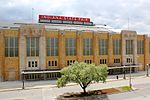Indiana State Fair

The Indiana State Fair is an annual state fair that spans 18 days in July and August in Indianapolis, Indiana, U.S. The Indiana State Fair debuted in 1852 at Military Park in Indianapolis and is the sixth oldest state fair in the U.S. It is the largest event in the state, drawing between 730,000 and 980,000 visitors annually since 2010. In 2015, readers of USA Today ranked the Indiana State Fair among the ten best state fairs in the country.The Indiana State Fairgrounds & Event Center has been the host site of the fair since 1892. Located about 4 miles (6.4 km) north of downtown Indianapolis, it encompasses 214 acres (87 ha), 72 buildings, a 6,000-seat grandstand, and a 1-mile (1.6 km) racetrack. The complex is home to year-round tenants and is used throughout the year for a variety of other gatherings, including trade shows, sporting events, and concerts.
Excerpt from the Wikipedia article Indiana State Fair (License: CC BY-SA 3.0, Authors, Images).Indiana State Fair
Coliseum Avenue, Indianapolis
Geographical coordinates (GPS) Address Nearby Places Show on map
Geographical coordinates (GPS)
| Latitude | Longitude |
|---|---|
| N 39.82995 ° | E -86.134355555556 ° |
Address
Coliseum Avenue
46205 Indianapolis
Indiana, United States
Open on Google Maps






